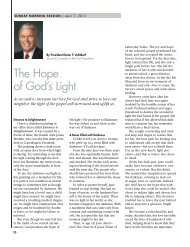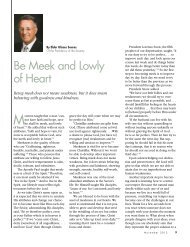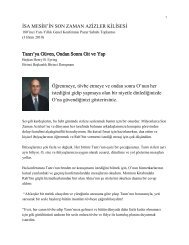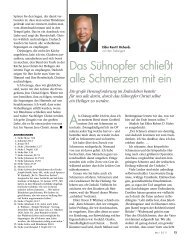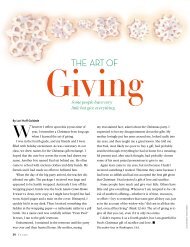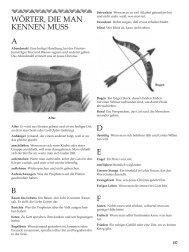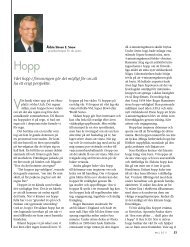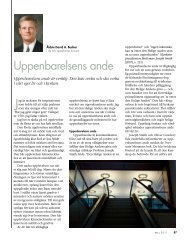August 2006 Ensign - The Church of Jesus Christ of Latter-day Saints
August 2006 Ensign - The Church of Jesus Christ of Latter-day Saints
August 2006 Ensign - The Church of Jesus Christ of Latter-day Saints
Create successful ePaper yourself
Turn your PDF publications into a flip-book with our unique Google optimized e-Paper software.
LEFT: ILLUSTRATED BY JOE FLORES; RIGHT: ILLUSTRATED BY BETH WHITTAKER<br />
I established guidelines but left the<br />
details to them. For instance, I gave<br />
them a set cash amount. <strong>The</strong>y had<br />
to first purchase healthy foods: milk,<br />
fruits, vegetables, meat, and other<br />
essentials. <strong>The</strong>y also had to add to<br />
our food storage. Only after the basics<br />
were purchased could they buy treats.<br />
Soon they realized that the money<br />
didn’t go far, and they started scouring<br />
the grocery store ads and clipping<br />
coupons. With a planned list in hand,<br />
one by one they accompanied me to<br />
the store, ready to be in charge. As we<br />
shopped, I explained unit pricing, and<br />
they decided on the best value. I<br />
would answer any questions they had,<br />
but the actual purchase decision was<br />
left to them, based on the budget and<br />
our family’s needs. At the checkout<br />
they proudly handed over their<br />
coupons and the correct amount<br />
from their cash envelopes.<br />
Once I let my children plan the<br />
grocery shopping, I seldom heard<br />
them complain that there was nothing<br />
to eat. Instead, they proved to be<br />
smart shoppers—a skill they were<br />
able to teach roommates when they<br />
moved away from home.<br />
Debbie VanDerwerken Schaffer, New York<br />
Emergency<br />
Water Storage<br />
Do you have enough water<br />
stored for your family in the<br />
event <strong>of</strong> an emergency? If so,<br />
is it stored properly? Adults need to<br />
FAMILY HOME EVENING HELPS<br />
Family Time Wheel<br />
To better include our<br />
two young children in our<br />
nightly family prayers and<br />
scripture study, we made a<br />
wheel-shaped chart during<br />
one family home evening.<br />
Using cardstock, we cut a<br />
circle and outlined four<br />
equal, pie-shaped sections—one<br />
for each<br />
member <strong>of</strong> our family.<br />
We then attached a<br />
spinning paper arrow<br />
to the center <strong>of</strong> the wheel<br />
with a brad. Next we<br />
labeled each section with<br />
an activity we wanted to<br />
accomplish every night:<br />
prayer, scripture study,<br />
drink at least two quarts <strong>of</strong> water each<br />
<strong>day</strong>. Children, nursing mothers, and ill<br />
people may need more. Additional<br />
water is needed for food preparation<br />
and hygiene—for a total <strong>of</strong> one gallon<br />
per adult per <strong>day</strong>. <strong>The</strong> <strong>Church</strong> recommends<br />
storing a two-week supply as<br />
a minimum. For an adult, that’s 14<br />
gallons (53 liters).<br />
According to providentliving.org,<br />
water storage containers should be<br />
thoroughly washed and should be<br />
airtight and resistant to breakage.<br />
Plastic soda bottles are commonly<br />
used. If the water has been treated<br />
with chlorine by a water utility, you<br />
do not need to add anything before<br />
storing it. If the water is not chlorinated<br />
and is clear, add eight drops <strong>of</strong><br />
bedtime story, and love.<br />
Whoever spins and lands<br />
on “love” gets to tell each<br />
family member one thing he<br />
or she loves about them.<br />
This simple nightly routine<br />
has enhanced our family’s<br />
communication and unity.<br />
Now when it’s time for<br />
nightly scripture study, my<br />
children race to our chart<br />
on the refrigerator to see<br />
what their part is during this<br />
special time <strong>of</strong> night.<br />
Stephanie Johnson, Utah<br />
household bleach (5 percent sodium<br />
hypochlorite) per gallon. If the water<br />
is not chlorinated and is cloudy, add<br />
16 drops per gallon. Seal the containers<br />
tightly, date them, and store them<br />
in a cool, dark place. Since many<br />
containers are clear, and light can permeate<br />
them, you may want to cover<br />
them or store them in dark plastic<br />
bags. Replace water every six months.<br />
Other water sources in your home<br />
include the water heater and water<br />
remaining in the pipes, but in the<br />
event <strong>of</strong> contamination, this water<br />
would need to be purified. Having<br />
ready, potable water available for<br />
immediate use is one <strong>of</strong> the most<br />
important ways to help your family<br />
be prepared for an emergency.<br />
ENSIGN AUGUST <strong>2006</strong> 71



